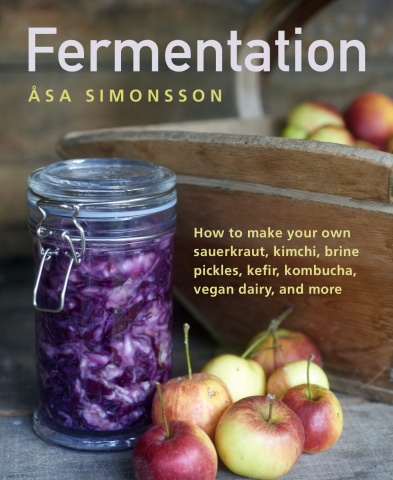Gut health? Fermentation is the Answer
Fermented foods are very much the ‘thing’ at the moment, and for very good reason, too. It’s really satisfying to line up a row of brightly coloured jars, packed with home-produced, healthy goodness! I normally limit my bottling skills to apple cheese and various chutneys, but I am inspired to spread my pickling wings a bit further now…
Swedish nutritionist, naturopath and nurse, Åsa Linéa Simonsson, has just written a great new book. Fermentation, published by Lorenz Books at £15, is a beautiful hardback tome, offering the ultimate lesson in fermented foods (of all kinds). It has step-by-step instructions, colour photos and loads of different recipes for all manner of delicious fermented foods: brine pickles, kimchi, kefir, kombucha, nut cheese and sourdough, to name but a few. Ferments are cheap and easy-to-make but full of sophisticated flavours, aromas and textures.
And the benefits of fermented food can be found in much more than cabbage sauerkraut. (Which, to be honest, I have never been keen on, but I’ve made ‘sauerkraut’ with another veg instead and it is yummy!) They have many benefits to get excited about – the benefits of pro and prebiotics are well recognised, especially in conjunction with our ever-increasing reliance on antibiotics. This book is a veritable ‘bible of fermentation’ and I know it is something I will be referring to again and again. To inspire you, here are a couple of recipes (The tomato salsa makes a change from chutney if you have loads of tomatoes ripening now!).
Aunty Birgitta’s Sauerkraut
Sauerkraut is called surkal in Swedish. There is no English word for sauerkraut but it literally translates as sour cabbage. This recipe is a typical Swedish surkal, and a favourite in our household. It can be made with just white cabbage or just red cabbage but personally I prefer a mixture of them both. It will aid your digestion when eaten with a meal and goes well with most dishes. It is good mixed into salads and in coleslaws. If you find sauerkraut a little too sour or sharp for your liking, you can mix in some mayonnaise. This will mellow the kraut and is a great way of giving it to children. A lovely condiment, this sauerkraut is very versatile. I always come back to this simple recipe. You will need a 1.5-LITRE/21⁄2-PINT JAR
500g/1lb white cabbage 500g/1lb red cabbage 2 large apples 15g/1 tbsp good-quality salt 30–60g/2–4 tbsp caraway seeds
1 Wash the cabbages or remove the outer leaves if they are damaged or ugly looking. One medium cabbage weighs around 1kg/21⁄4lb so if you mix the colours you will need half a cabbage of each.
2 Now grate the cabbages on a mandolin, a hand grater or in the food processor on the slicing blade, or cut finely with a sharp knife. The end result should be long thin slices. Grate the apple on a standard coarse vegetable grater. I don’t normally use the core of the cabbage, but there is no reason not to. I more often use it as a weight to push down the cabbage in the jar.
3 Put the shredded cabbage and grated apple in a mixing bowl and add the salt and caraway seeds, mixing with your hands. To save your hands, you can leave the bowl standing for 15 minutes for the water to come out of the vegetables naturally before massaging.
4 Massage the cabbage until there is a fair amount of water in the bottom of the bowl and the cabbage looks slightly ‘cooked’.
5 Transfer the cabbage to your clean fermentation jar, packing it in tightly with your fist or a pounder so that the cabbage is underneath the water surface with no hidden air bubbles. If there is not enough water to cover the vegetables add some filtered water. Leave around 5cm/2in from the surface of the water to the lid of the jar. This is to leave enough space for the gases to come out.
6 Put a weight on the vegetables to keep them under the water surface.
7 Let the vegetables ferment at room temperature for approximately 3 weeks. Check regularly that the vegetables are underneath the water. If you do not use a proper fermentation crockpot or special fermentation lid, don’t forget to burp the jar once a day to let the gases out; this means to quickly open the lid to let the air out and then close it.
8 When the ferment is ready, transfer to smaller jars and store in the fridge. It will keep for months if unopened.
Tomato and Coriander Salsa
Tomato is technically a fruit, and this specific recipe requires a probiotic ‘starter’. This salsa is a wonderful- tasting fermented sauce and if treated with care it will last for several months in your fridge. Use just as you would any other salsa sauce, as a dip or a condiment. It is excellent with tacos and other Mexican food. 1-LITRE/13⁄4-PINT JAR
750g/11⁄2lb tomatoes1⁄2 green bell pepper small bunch of fresh coriander1⁄2 red onion1 garlic clove1 spring onion1⁄2 fresh green or red chilli (depending what strength you want in your salsa) 30ml/2 tbsp raw apple cider vinegar15g/1 tbsp cumin seeds5–10g/1–2 tsp good-quality salt1 probiotic capsule (content only)
1 Wash the tomatoes, green pepper and herbs. Peel the onion and garlic.
2 Dice the tomatoes, green pepper, onion and spring onion, to your preferred salsa size. Chop the coriander and chilli small. Grate the garlic.
3 Combine all the fresh ingredients in a mixing bowl with the vinegar, cumin seeds and salt, and mix by hand.
4 Take half of the mixture out and put into a blender or food processor, and blend to a purée. Return the purée back to the mixing bowl with the rest of the salsa and stir together well. This stage is optional but will give you more of a salsa texture.
5 Add the content of the probiotic capsule to the salsa, and stir.
6 Place the mixture into your clean fermentation jar. There should be enough liquid to cover, and for this ferment, there is no need to put any weights on it, just make sure there are no air bubbles. Make sure there is 5cm/2in space left below the jar opening for gases to escape into.
7 Let the salsa ferment in your kitchen for 3–5 days. Burp it daily if you remember. The tomatoes will begin to separate from the liquid when it is ready. Stir and taste it on the third day – if it is already slightly bubbly and tasty, move it straight to the fridge.
8 It is best to decant your salsa into smaller jars when ready, then unopened the jars will last for at least 2 months in your fridge. If opened use up within a couple of weeks.
Happy fermenting folks!
Twickenham & Richmond Tribune


